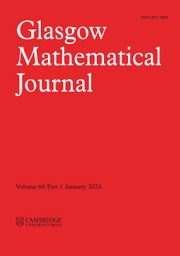Article contents
Remarks on the range of a vector measure
Published online by Cambridge University Press: 18 May 2009
Extract
A long-standing problem is the characterization of subsets of the range of a vector measure. It is known that the range of a countably additive vector measure is relatively weakly compact and, in addition, possesses several interesting properties (see [2]). In [6] it is proved that if m: Σ → Χ is a countably additive vector measure, then the range of m has not only the Banach–Saks property, but even the alternate Banach-Saks property. A tantalizing conjecture, which we shall disprove in this article, is that the range of m has to have, for some p > 1, the p-Banach–Saks property. Another conjecture, which has been around for some time (see [2]) and is also disproved in this paper, is that weakly null sequences in the range of a vector measure admit weakly-2-summable sub-sequences. In fact, we shall show a weakly null sequence in the range of a countably additive vector measure having, for every p < ∞, no weakly-p-summable sub-sequences.
Information
- Type
- Research Article
- Information
- Copyright
- Copyright © Glasgow Mathematical Journal Trust 1994
References
REFERENCES
- 1
- Cited by

